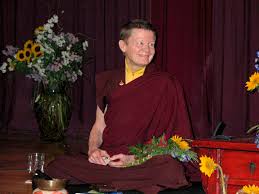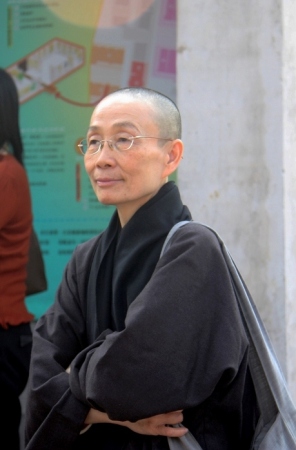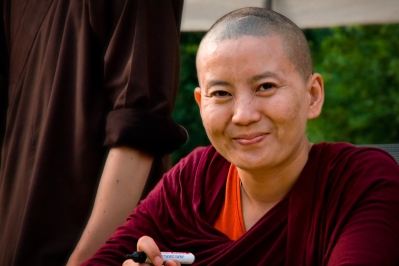 The origins of the Buddhist Nuns ‘ Order are a contentious issue in Theravada Buddhism. Paradoxically, it is also the issue that is not discussed a lot. Which is surprising, as in current Buddhism there is a gaping hole where a Theravada Bhikkhuni (Nuns) community should be. The prevailing view is that the nuns’ full ordination line was irrevocably lost long in the past and cannot be restored.
The origins of the Buddhist Nuns ‘ Order are a contentious issue in Theravada Buddhism. Paradoxically, it is also the issue that is not discussed a lot. Which is surprising, as in current Buddhism there is a gaping hole where a Theravada Bhikkhuni (Nuns) community should be. The prevailing view is that the nuns’ full ordination line was irrevocably lost long in the past and cannot be restored.
There are separate attempts here and there to bring Theravada Nuns’ Order back, including Ajahn Brahm’s ordaining a group of nuns in Dhammasara Monastery in Australia in 2009. This resulted in severe criticism by some Theravada religious leaders and expulsion of Ajahn Brahm and the monastery he leads from the organisation of the Sangha of Wat Nong Pah Pong.
 Mahayana Nuns receive full ordination, as it is considered that historically the Order did not lose continuity since the Buddha’s times. However, for both Theravada and Mahayana something called “The Eight Garudhammas” – the eight heavy rules – remain a painful issue. These are the rules that the historical Buddha is supposed to have given the first nuns to whom he gave ordination. These eight rules were the condition on which the Buddha would even allow women to become Bhikkhuni.
Mahayana Nuns receive full ordination, as it is considered that historically the Order did not lose continuity since the Buddha’s times. However, for both Theravada and Mahayana something called “The Eight Garudhammas” – the eight heavy rules – remain a painful issue. These are the rules that the historical Buddha is supposed to have given the first nuns to whom he gave ordination. These eight rules were the condition on which the Buddha would even allow women to become Bhikkhuni.
In 2001, Venerable Shih Chao-hwei, accompanied by two monks, two nuns, two laymen, and two laywomen, tore apart a copy of the rules. This took place at an academic conference on Humanistic Buddhism in Taipei. Academic debates had preceded this act, including those on the pages of the Sangha Magazine since 1992, and criticism and outrage followed. You can read an academic article by Chiung Hwang Chen about the event in Journal of Feminist Scholarship, available online for free.
The Eight Rules put a Bhikkhuni in a subordinate position to Bhikkhu in various circumstances of monastic life. One rule, for instance, requires a nun to rise up and bow to a monk, even if she has been ordained decades ago, and he only the day before.
 Of course I oppose each of these rules and I believe that contrary to what they say, a Bhikkhuni can certainly give discourses to Bhikkhu, or admonish Bhikkhu. And if a nun should do penance before both male and female Sanghas, so should monks.
Of course I oppose each of these rules and I believe that contrary to what they say, a Bhikkhuni can certainly give discourses to Bhikkhu, or admonish Bhikkhu. And if a nun should do penance before both male and female Sanghas, so should monks.
How do I relate to the fact that the Buddha, the founder of the spiritual tradition I follow, said these things? Apart from numerous claims by feminist scholars and nun-sympathetic male Buddhist leaders that the rules were not in fact given by the Buddha, but are later additions to the Canon, let’s look at the situation.
The Buddha’s aunt and step-mother, Mahapajapati herself asks for admission and then Ananda, the Buddha’s cousin and attendant, asks for same, but he refuses. Then Ananda asks the Buddha if women at all can achieve the same Enlightenment as men. The Buddha says yes. Here is already enough information for me: women can achieve Enlightenment.
However, when I say “for me”, I mean exactly this social identity, raised under particular circumstances and given particular opportunities in life. I never subscribed to any patriarchal rules, written or unwritten, and if I experience negative consequences of patriarchy, I have ways of confronting them. I came to Buddhism with this luggage. The conditional in me: my upbringing and my outlook had put me in a position that allows me to ignore the Eight Heavy Rules. For me Enlightenment is unconditional. It is beyond what even the Buddha said.
That is me, living in the Global North in the 21st century, being a laywoman. Suppose I was a Buddhist nun or a laywoman living in the past. What effect would it have had on me to see the male Monastic Order being so elevated over the female one? Would it affect my spiritual confidence and even efforts? Would it put me off from striving? I would say – most probably. And as in this conditioned world effect follows cause, more Buddhist women who are made to fell inferior, beget more Buddhist women who feel inferior.
 Thus, although Enlightenment is beyond this world, the means and the roads to it are firmly in this world. There is a sticky issue in Buddhist history that many feminists, including on this blog, point to. This is the issue of the Buddha’s living his family to become enlightened. I usually respond to this by saying that practically speaking, if you think through all the conditions of patriarchal India 2,500 years ago, this was the only way humanity could have got the Buddha’s teaching of end of suffering. The Buddha would not have practiced what he practiced had he stayed in the palace. The Buddha had to be a man because of the structure of the then spiritual life and organisation.
Thus, although Enlightenment is beyond this world, the means and the roads to it are firmly in this world. There is a sticky issue in Buddhist history that many feminists, including on this blog, point to. This is the issue of the Buddha’s living his family to become enlightened. I usually respond to this by saying that practically speaking, if you think through all the conditions of patriarchal India 2,500 years ago, this was the only way humanity could have got the Buddha’s teaching of end of suffering. The Buddha would not have practiced what he practiced had he stayed in the palace. The Buddha had to be a man because of the structure of the then spiritual life and organisation.
However, by the same token, the Buddha should have realised, that although women could achieve Enlightenment even without being officially admitted into the Order, in reality, the Establishment of the Female Monastic tradition was essential for women’s striving toward Liberation.
Interestingly enough, Ananda made this point to the Buddha. Ananda said that Mahapajapati had brought the Buddha up, and now he was refusing her admission. What Ananda seems to be saying is that without his step-mother’s care and nurturing the Buddha would not have been where he was – he would not have grown to be the man he became, the Enlightened One.
Oxana Poberejnaia is a content writer at http://content4you.org. She was an Officer of the University of Manchester Buddhist Society while studying for a PhD in Government, and has been involved in organising the Manchester Buddhist Convention, now in its 9th year. Oxana is now exploring the Sacred Feminine through marking seasonal festivals, working with her menstrual cycle, frame drumming and shamanic journeying, while keeping the practice of Buddhist meditation. Oxana is an artist and an author. Her works can be found on her blog.


The reestablishment of the bhikkhuni order in theravada Buddhism was first initiated by ordination at the Mahabodhi temple at Sarnath in India in 1996 followed by several ordinations (including one in Crenshaw, Los Angeles almost 2 years ago), and has been very successful, with hundreds of bhikkhunis in Sri Lanka now and largely accepted by the monks and lay people there. However, it is still illegal to be a fully ordained Buddhist female in Myanmar.
The issue of 8 garudharma is more a theoretical issue as far as ordination is concerned. They did not feature at all in my ordination ceremony, and I can’t think of any nun who believes them. Mainly they serve to promote chauvanistic culture among the monks and women who are more comfortable in “second class.” HH Dalai Lama recently made a public comment in Delhi denouncing observation of certain social customs related to the spirit if not material of the 8 garudharma.
The best text for understanding the early history of women’s ordination is Sister Bhikkhuni Kusuma’s 1999 PhD dissertation entitled “The Bhikkhuni Vinaya: A Study of the Vinaya Rules of Bhikkhunis and Translation of the Pali Bhikkhuni Patimokkha with Commentarial References.” It includes convincing refutations of the Garudharmas and other historical and canonical misrepresentations of the bhikshuni order.
Unfortunately, as far as I know, it has never been published, and is an urgent task awaiting a scholar looking for a worthwhile project.
HH Karmapa is on record affirming his intention to help full ordination reach Tibetan nuns.
Prof Bhikshuni Karma Lekshe Tsomo at U San Diego is the most knowledgeable academic scholar on ordination of Buddhist women in North America.
LikeLike
This is so interesting, thank you.
LikeLiked by 1 person
Dear Bhikshuni Trinlae, thank you very much for your informative comment.
LikeLike
The Sakyadhita International Association of Buddhist Women, founded in 1987, has an amazing website, with all sorts of interesting resources to explore. Sakyadhita means “Daughter of the Buddha” — see sakyadhita.org
LikeLike
Hello, Sarah! Thank you for this contribution.
LikeLike
Ok, I realize this will get some Buddhists hating on me, but I always looked at Buddha’s step-mother (I thought she was also his mother-in-law?) as this rather over-bearing woman who was always putting her nose in his business. I mean, someone had to go along with that “keep safe in the palace” plan, right? Anyhow, so here he’s gone and escaped from her control and once again she’s putting her nose in his business and bringing along 500 extra women just to add onto the peer pressure. Buddha doesn’t really want her around, so he comes up with these outrageous conditions hoping to deter her, only he can’t. She’s determined. And so in accepting these conditions, she still gets to keep her nose in his business, but he can tell her to butt out at any time, and she’ll have to because those are the conditions of the contract.
LikeLike
Hello, nmr! That’s witty and funny, and enjoyed your comment.
LikeLike
Oxana, Thanks for this “enlightening” post! Understanding patriarchy in all its religious trappings as well as the feminist pushes for change is so exciting! I love it!
LikeLike
Hello, Nancy and thank you very much! I confess I still don’t understand the whole origins of the nuns’ order, whether the text is authentic, and if so, what reasons exactly the Buddha had. I also do not completely understand the current situation with Buddhist nuns in Theravada and various Mahayana orders… So, there is a lot to learn.
LikeLike
It has been my experience that for many, love and renunciation are difficult concepts to grasp because there are a number of people who have not experienced love in their lives and an impossibly small amount of people who have so much love for the world that they are willing to give up all that they have for others. For me, the life of Siddhartha Gautama is a tale of love and renunciation.
Foretold that his son would be a great holy man, King Suddhodana ensured that as his son grew to manhood, he would only know pleasure so that he would choose a life of kingship over a religious one. However, Prince Siddhartha must have been a very kind and sensitive man, because in spite of this upbringing that so often leads to behavioral problems resulting from overindulgence, upon seeing the Four Sights (an old person, a sick person, a dead person, and a holy man), he was deeply saddened by their suffering. In fact, he was so disheartened that he renounced everything.
Now, I don’t know about you, but I have a difficult time just giving up chocolates and mind-numbing television. I can barely imagine what it would be like to give up every pleasure you have known: your future kingdom (your throne), your treasures, your wife, your son, your friends, your safety, your security, and all that you have in order to end the suffering of strangers, those unknown and, often thankless, others. Siddhartha went from the extremes of hedonism to the extremes of asceticism, trying to find the path that would end suffering, and he found it in the middle way, the path of no extremes.
Because it is said that you have to be a Buddha to recognize a Buddha and since I would not give six years of my life trying to end the suffering of others, it is difficult for me to literally see those who have progressed so far along this path. Fortunately, I have known a tremendous amount of love and so this is what I recognize in the story of the Buddha. I see a father, King Suddhodana, who so loved his son that he wanted him to be happy and to protect him from the cruel life of a wandering monk. I see an aunt, Mahapajapati, who so loved her nephew that she could see the wisdom of his path. Also, I see the love of the son, Rahula, who was not resentful but followed his father and became a monk, as well as the blessed cousin, Ananda. And the wife and cousin of Prince Siddhartha, Yasodhara, was reputed to have also become a nun.
Our vision is limited by what we know, so perhaps the best way to see Buddha is to give your everything to love.
LikeLike
FYI: The Numata Center for Buddhist Studies at the University of Hamburg, in cooperation with the Women in Buddhism Study Initiative, offers an E-learning Course on Women in Indian Buddhism. The course consists of a series of lectures by a group of international scholars. Participation is free of charge and open to anyone interested, but requires online registration. Lectures start on April 16 and are held every Thursday at 2.15 pm German time. Recordings of the lecture are accessible for registered participants at any time of their convenience after original delivery. The e-learning platform also features a discussion forum for exchange between participants and lecturers.
For registration and more information, please follow this link: http://www.buddhismuskunde.uni-hamburg.de/E-Learning-Bhikkhuni.course_bhikkhunis.0.html?&L=1#c2774
LikeLike
Great, thank you, Karen!
LikeLike
Hello, Karen Nelson Villanueva! Thank you for this lovely and heart-warming post! Best of luck in all your spiritual endeavours! Metta!
LikeLike